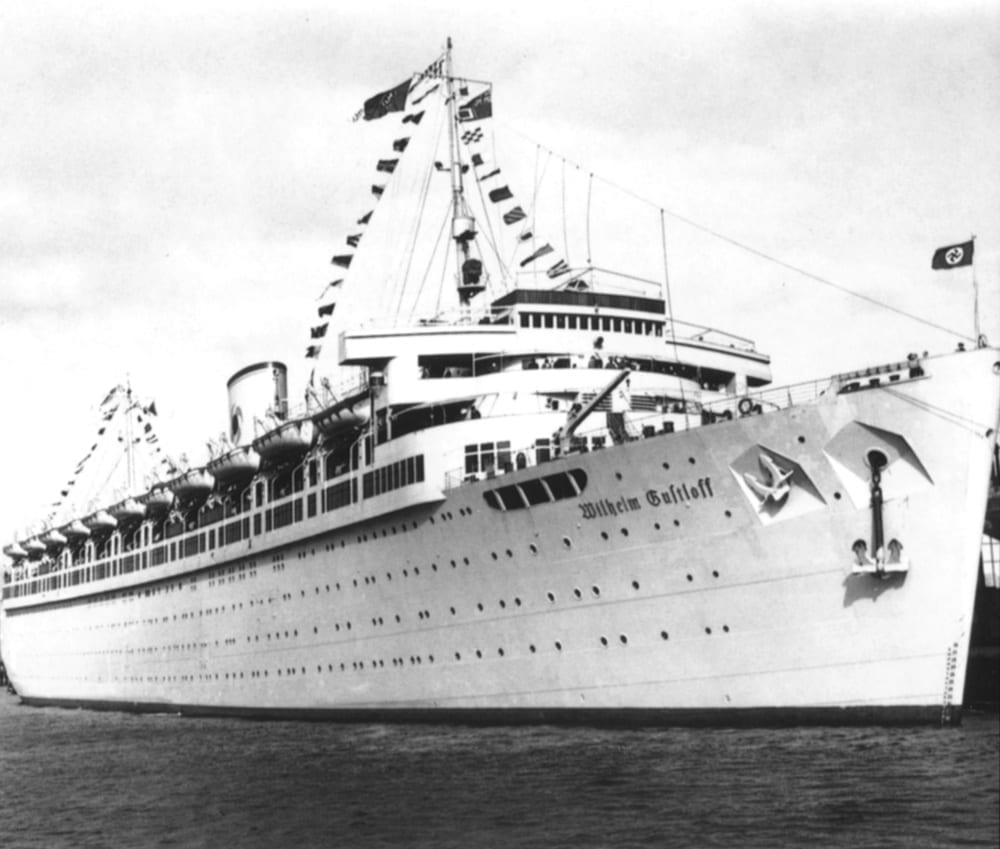It was 30th January of 1945 when Wilhelm Gustloff sunk, only seventy minutes after it left the port. A small fleet of boats and ships arrived at the scene where this colossal liner sunk, to try and save as many people possible. The water was too icy, so all of them couldn’t be saved in time. A thousand survived, but an estimated number of 9,343 people weren’t as lucky. That much died, most of them being children. The number of people who vanished in Wilhelm Gustloff catastrophy is six times greater than the number that died when Titanic sunk in 1912.
Most people have heard of the Titanic thanks to the 1997 movie made by James Cameron, but the sinking of Wilhelm Gustloff is the biggest maritime disaster in history.

Wilhelm Gustloff – The Luxury Liner
The ship was named after the leader of Swiss Nazi Party who was assassinated in his home in February 1936. The vessel weighted 25,000 tons and was 700 feet long. It was an impressive sea vehicle that could take 2,000 people on board. It was launched in 1937, and its primary purpose was to be a cruise ship for the German workers in Hitler’s Third Reich. It held this job until the second World War broke out.
Wartime
At the beginning of the war, Wilhelm Gustloff was used as a hospital ship. Later it was stationed at the dock in Gdynia on the Baltic sea serving as barracks for U-boat trainees. When Operation Barbarossa was launched, Germans almost managed to enter the Moscow, but when the tides of war turned to Soviet favor, the battles were fought on German soil in East Prussia. By October 1944 Red Army was already deep into Nazi territory.

The Red Army Approaches
With Soviets destroying everything in their path the civilians of East Prussia feared for their lives and were fleeing towards the Baltic sea. They were hoping for an evacuation, but all they found were the Russian soldiers who brought devastation to everything on their path. The same treatment they got from Germans when Nazis invaded their homeland.
Wilhelm Gustloff, just like any other shi at Baltic was used in an attempt to evacuate Germans from this area. The port of Gotenhafen was almost frozen and people panicky tried to find their place on the ships that would guarantee them the escape.
Evacuation
The ship was scheduled to leave the port on January 30th, and by that time more than 10,853 people boarded cramping one another. If you remember, from the first part of our article, the ship was intended for only 2,000 passengers. At the moment of its departure ship had only one torpedo boat as its escort and four captains on board. They argued which route was the best to take, fighting among themselves. Heavy snow, icy water, and poor visibility didn’t help their cause.

The ship was running without lights in order to avoid detection, but when they encounter German minesweeper convoy, they turned the lights on in an attempt to avoid a direct collision. Unfortunately, when they turned the lights on, they became visible to one Russian submarine which was lurking nearby.
Hit
From the direction of the submarine, three torpedoes were fired, and all of them hit the designated target. The explosions caused a panic that could not be contained. With most of the life-saving boats being unable for use due to freezing temperature, passengers had no way to save themselves. Many died from suffocating after being cramped on the stairways after the panic broke out. Others jumped to their death. Most of the children died straight away as their life jackets were too big. The strange coincidence of this sinking is that it happened on the birthday of Wilhelm Gustloff, born on 30th January 1895. It was also twelve years since Hitler rose to power on that day in 1933. So, with facts like these surrounding this ship why is the sinking of Titanic better known. We’re here to give you an answer.
1. It happened during the wartime. Titanic seems more tragic because it occurred during peacetime.
2. Regardless of the fact that these people were civilians, the victims were Germans, which committed numerous crimes during the war. There was no sympathy for them.
3. Germans were guilty of the war, and no one listened to their complaints about civilian deaths in the post-war period.
4. The Soviet Union was under Nazi occupation for years, with their people suffering as a consequence of this. When their counter-offensive started, they showed no mercy towards German soldiers and civilians.
5. The world had no sympathies for Germans after war crimes and systematic genocide Germany did during the war.
6. The ship was named after a leader of Nazi Party, and many wonder if the same would happen if it had a different name.
7. In months after the tragedy, no one reported about the sinking. It wouldn’t have sounded good on the news that an allied country killed so many women and children.
8. There was no Hollywood movie about it. The ship wasn’t sailing towards the US, nor it had its citizens on board. No one wants to make a Nazi-sympathetic film.
9. None of the victims were wealthy, or prominent in any other way.




